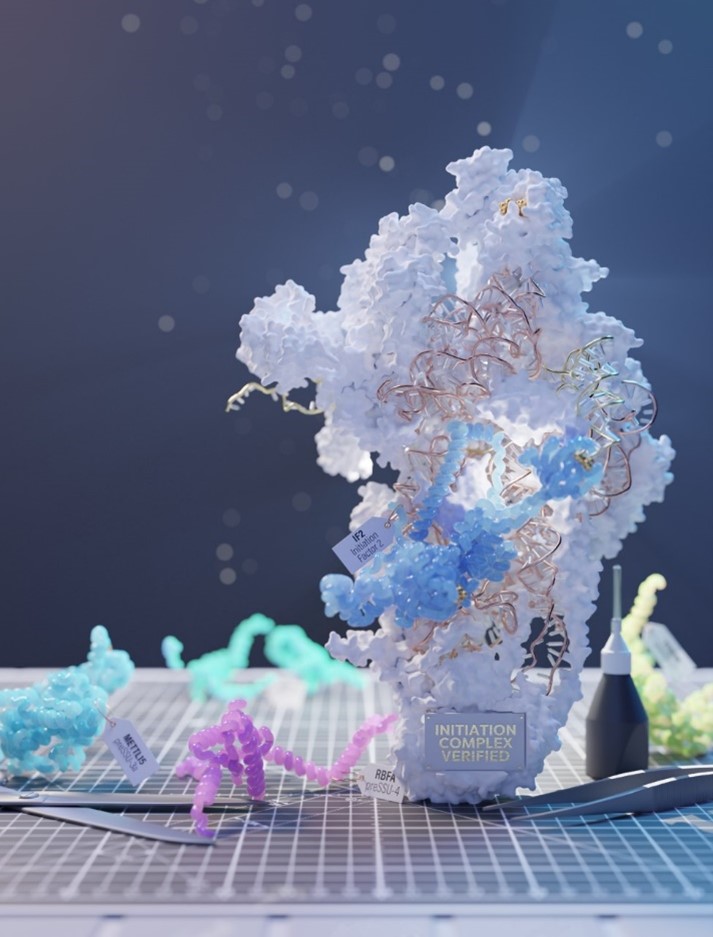Keep up to date with the latest research and developments from Diamond. Sign up for news on our scientific output, facility updates and plans for the future.
Mitochondrial ribosomes (mitoribosomes) are nanoparticles essential for the synthesis and maintenance of bioenergetic proteins. These proteins produce more than 90% of the energy in our bodies. The structure of the mitoribosome, first resolved eight years ago, consists of over 80 different components, and thus requires assembly factors to help put the complex machinery together. Despite recent advances in understanding the structure and function of the mitoribosome, there is still a lack of information on how the individual mitoribosomal components assemble, and crucially how this links to mitoribosome function. This missing information is critical since defects in the assembly are linked to metabolic disorders, particularly age-related diseases that are associated with decline in mitochondrial function and biogenesis.

In recent findings published in Nature, a team of international researchers led by Prof. Alexey Amunts (Stockholm University) used cryo-electron microscopy (cryo-EM) at Diamond’s electron Bio-Imaging Centre (eBIC) to analyse a series of intermediate states in the assembly of the mitroribosome. Cryo-EM permits unique insight into dynamic structural processes, where the team (collecting data remotely) identified eight distinct intermediate states in the multi-step assembly pathway. This included a sequence of assembly factors interacting with each other as an integrated network. Further, the atomic level spatial resolution enabled the discovery of a mitochondria-specific protein which blocks premature binding of genetic material, and also enabled detection of essential structural modifications that occur on the mitoribosomal core at each of the assembly steps.
This study identified the chain of events involved in mitoribosome assembly and revealed a new paradigm for a single protein, ms37, linking the assembly to the function of the mitoribosome. The data collected support a unique function for this protein in cell mitochondria. More broadly, this work demonstrates that it is now possible to characterise dynamic processes occuring inside cells, with minimised disruption to the specimen’s native state. Combined with the high spatial resolution achievable using cryo-EM, this opens the door to new avenues for study, for example the visualisation of antibiotics bound to mitoribosomes. This approach could be exploited to determine modifications that induce off-target binding (leading to side effects) and ultimately support the design of more efficient antibiotics.
Remarkably, results showed that the protein mtIF3 (previously known as “initiation" factor) in fact binds during the assembly, and a unique protein mS37 then disrupts its contact. This event marks the completion of the mitoribosome assembly and the initiation of protein synthesis.
Itoh, Y., Khawaja, A., Laptev, I., Cipullo, M., Atanassov, I., Sergiev, P., Rorbach, J. and Amunts, A., 2022. Mechanism of mitoribosomal small subunit biogenesis and preinitiation. Nature, pp.1-6.
Electron microscope Titan Krios I at the electron Bio-Imaging Centre (eBIC).
Scientific disciplines: Life Sciences & Biotech; Structural Biology
Technique: Cryo-electron microscopy (cryo-EM)
iNEXT; EU; Swedish Foundation for Strategic Research; Ragnar Söderberg Foundation; ERC; Knut and Alice Wallenberg Foundation; Max Planck Institute; Karolinska Institutet; Wallenberg Fellowship Program; EMBO; Lomonosov Moscow State University
Diamond press office: Isabelle Boscaro-Clarke, Head of Communications, [email protected]
Cryo-EM: Karen Davies, Principal Electron Microscopy Scientist on eBIC, Diamond Light Source, [email protected]
Corresponding author: Alexey Amunts, Stockholm University, [email protected]
Diamond Light Source is the UK's national synchrotron science facility, located at the Harwell Science and Innovation Campus in Oxfordshire.
Copyright © 2022 Diamond Light Source
Diamond Light Source Ltd
Diamond House
Harwell Science & Innovation Campus
Didcot
Oxfordshire
OX11 0DE
Diamond Light Source® and the Diamond logo are registered trademarks of Diamond Light Source Ltd
Registered in England and Wales at Diamond House, Harwell Science and Innovation Campus, Didcot, Oxfordshire, OX11 0DE, United Kingdom. Company number: 4375679. VAT number: 287 461 957. Economic Operators Registration and Identification (EORI) number: GB287461957003.